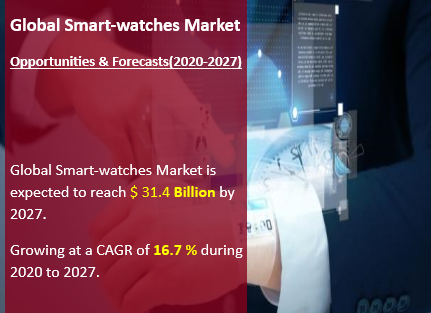Report Overview
The report provides market estimates for base year 2019 and a yearly forecast to 2027 in terms of revenue (USD Billion) unless stated otherwise. Market for each segment has been provided on a global and regional for the above-mentioned forecast period.
Smartwatch is a portable wearable device in the form of a wristwatch. Modern smartwatches offer touchscreen and it is used to track various activities such as tracking the daily steps,, calories burnt, heart rate, digital time telling and others. Smartwatch is similar to mobile phone device with a touchscreen display and consists of various apps through which a person can access his mobile phone. Increase in adoption of smartphone along with fast internet connectivity is the key driver for the growth of the global smartwatch market. As of now, the market is driven by leading tech companies such as Xiaomi, Samsung, Apple, Google, Fitbit Inc. and others.
COVID-19 Impacts
COVID-19 is a new strain of corona-virus that has not been previously identified in humans. Corona-viruses (CoV) are a family of RNA (ribonucleic acid) viruses. COVID-19 started in Asia and is now spreading over the rest of the world via person-to-person contact and community spread. COVID-19 pandemic may have a potential impact on Global Market.
Report Includes
- The report provides information about the current and upcoming trends in the market from 2020 to 2027, which helps determine the prevailing opportunities.
- The report includes information related to key drivers, restraints, and opportunities with a detailed impact analysis.
- The study provides an in-depth analysis of the market with current trends and future estimations to elucidate the imminent investment pockets.
- 42 Market data Tables and 48 Figures.
- The current market is quantitatively analyzed from 2020 to 2027 to highlight the financial competency of the smartwatch market.
- Up-to-date analyses of competitive developments, such as expansions, joint ventures, new products launches, expansions, and mergers & acquisitions in the global personal protective equipment market.
- Key market players within the market are profiled in this report and their strategies are analyzed thoroughly, which help understand the competitive outlook of the global market.
- Comprehensive analysis of factors that drive and restrict the growth of the market is provided.
Scope of the reports
- The global market is witnessing a huge influx of companies, which is why it is expected to grow manifold from the existing 40 companies. The scope of this report includes the analysis of various regions, namely, North America, Europe, Asia-Pacific, and LAMEA.
- This study presents an analytical depiction of the global smartwatch industry along with the current trends and future estimations to depict the imminent investment pockets.
- The overall smartwatch market potential is determined to understand the lucrative trends to gain a stronger foothold in the industry.
- It also explains the major drivers and current trends within the particular sector.
- This report provides a quantitative analysis of the current trends, estimations, and dynamics.
- In-depth analysis of the market segmentation assists in determining the prevailing market scope.
- The key countries in all the major regions are mapped on the basis of their market share.
Trend and Development
Innovation in smart watch for variety of applications is supporting growth of the smart watch market. North America market is rising rapidly due to recent innovations in smart watch products, which offer unique capabilities of products and provides benefits to manufacturers. With the evolution of new technologies, the number of applications of these technologies is increasing in North America region.
As there is increase in demand of smart watch in smart wearable industry, the tech giants are bringing innovative smart watch for activity tracking, heart rate monitoring, message notifications, voice recording, calls, reminder etc. This tech giants offer smart watch based on competitive pricing that helps to increase their customer base. This increasing competitiveness among prominent players such as Apple Inc., Fossil Group, Samsung, and Lenovo Corporation etc. to launch smart watch has triggered the growth of smart watch market in Asia Pacific region.
North America accounted for the highest market share of 35% in 2013; this is mainly due to higher purchasing power as well as increasing demand for fitness tracking equipment. Asia Pacific is expected to be the fastest growing regional market over the next six years. The regional market is expected to be driven by high smartphone proliferation and usage of Internet services.
Segments covered in the reports
This research report categorizes the Global Smart-watches Market on the basis of region, countries, application, type and operating system from 2020 to 2027 covering the below points-
On the Basis of Region: North America, Europe, Asia-Pacific and Lamea.
On the Basis of Countries: United States, Russia, China, Germany, United Kingdom, France, Japan, Israel, Saudi Arabia, South Korea, United Arab Emirates, Canada, Switzerland, Australia, India, Italy, Sweden, Spain, Belgium, Netherlands, Norway, Italy, Brazil, Argentina, Mexico, South Africa and others.
On the Basis of Application: Personal Assistance, Wellness, Healthcare, Sports and Others
On the Basis of Operating System: WatchOS, Android /Android Wear, Linux, Pebble OS, RTOS, Tizen and Others
On the Basis of Type Extension Smart Watch, Standalone Smart Watch, Classical and Hybrid Smart Watch
Major Players in the Global Smart-watches Market are:
Fitbit Inc., Apple Inc., Google Inc., Garmin, Motorola, Samsung Electronics Co., Ltd, Sony Corporation, Garmin Ltd., Fossil Group, Inc.,Lenovo, Huawei Technologies Co., Ltd., Xiaomi Corporation, Nokia Corporation, LG Electronics Inc. and Others
Report coverage
- Recent Trend and Developments: The major players operating in the global market have adopted key strategies such as product launch and acquisition to strengthen their market outreach and sustain the stiff competition in the market.
- Key Market Players: Key players list and Key companies profiled in this market include.
- Revenue forecast, company share, competitive landscape and growth factors.
Objectives of the study
To provide detailed information regarding drivers, restraints, opportunities and challenges are influencing the growth in the respective market. To analyze the competitive intelligence of players based on company profiles and their key growth strategies. To strategically analyze micro markets with respect to the individual growth trends, their prospects, and their contribution to the total respective market. To analyze competitive developments such as expansions, and product launches, along with research & development (R&D) activities undertaken in the respective market. A unique model is created customized for each study also offers suggestions that help enterprises to identify and mitigate risks.
Note –
- GIR Reports will also support you post-purchase for a period of 6 months to answer any of your queries related to the following market and to provide you any more data if you need, for your analysis.
- Also, you can buy some selected Chapters from the report.
FREQUENTLY ASKED QUESTIONS?
- What is the total market value?
- What will be the growth in 2027?
- What are the key trends in the market?
- What are the major players in the markets?
- What are the key growth strategies of industry players?
- Which region would offer a higher growth?
- What are the countries included in the rest of the word segments?
- How can I get report sample?









